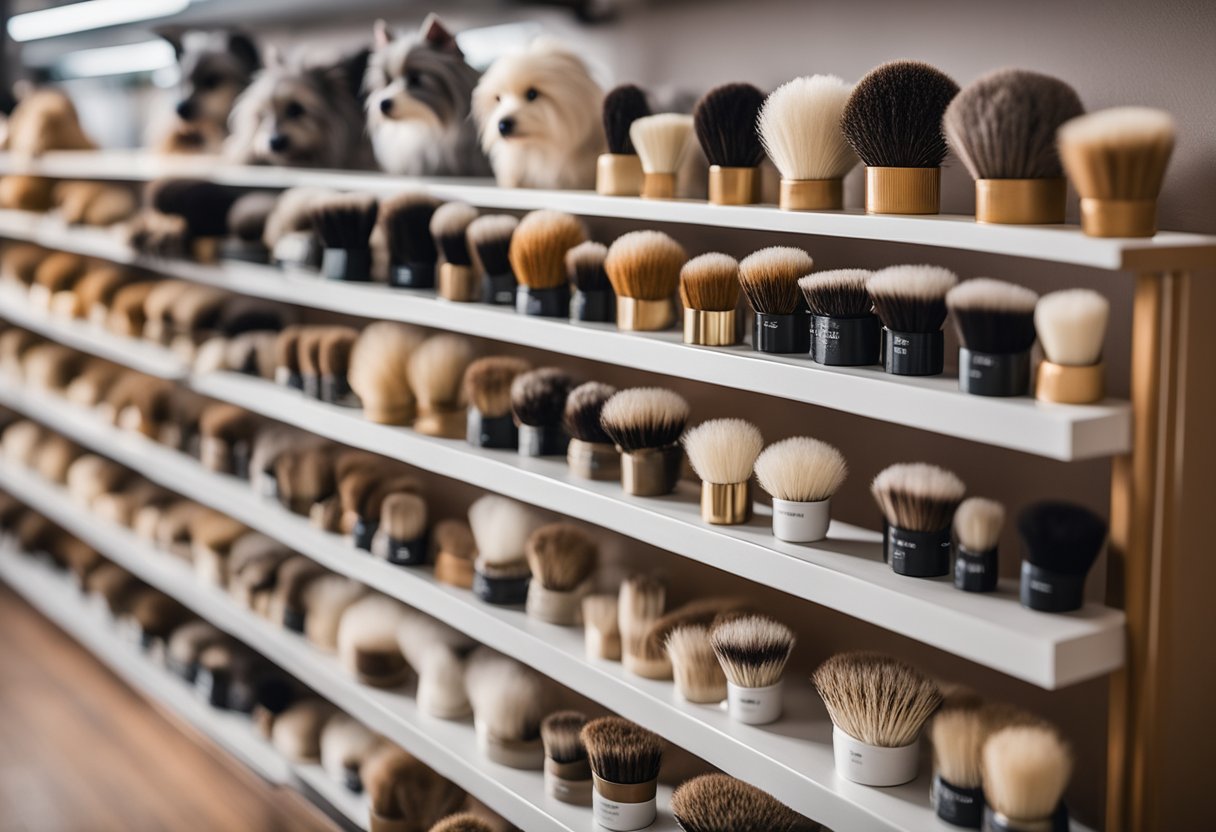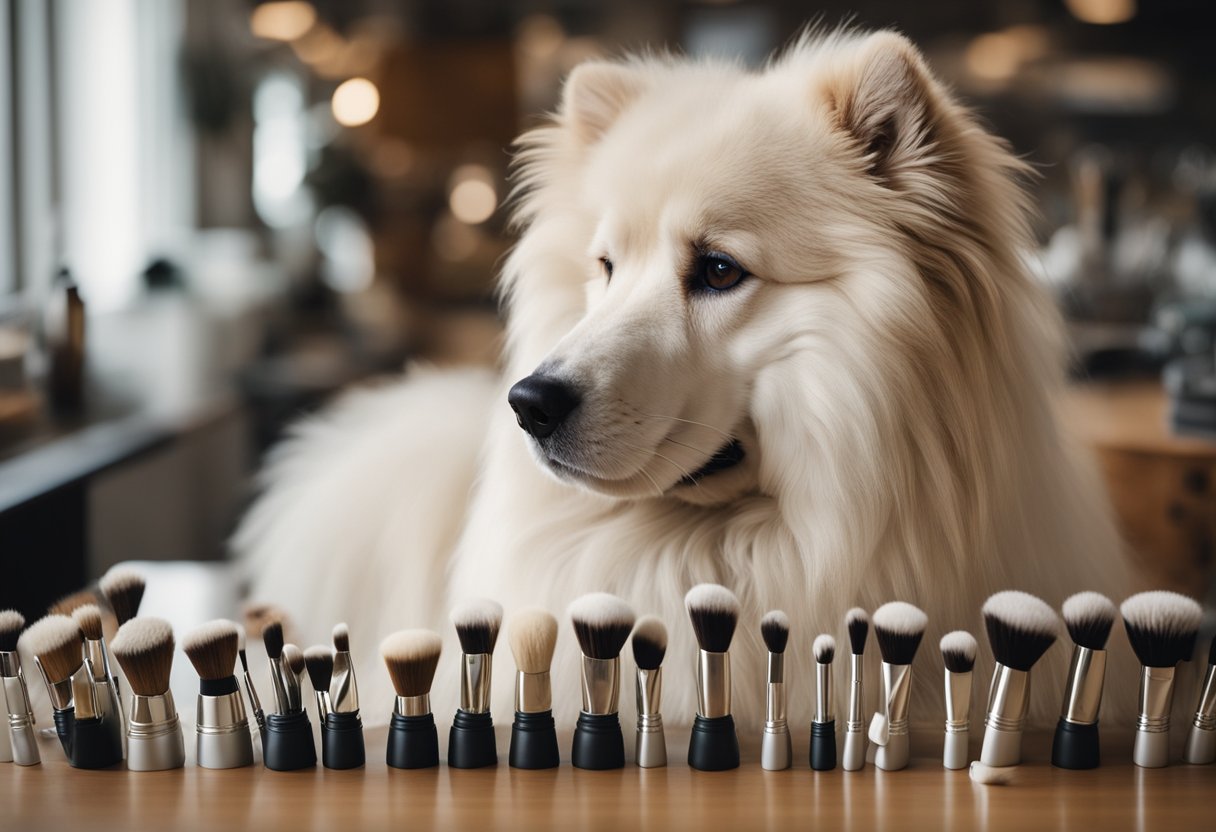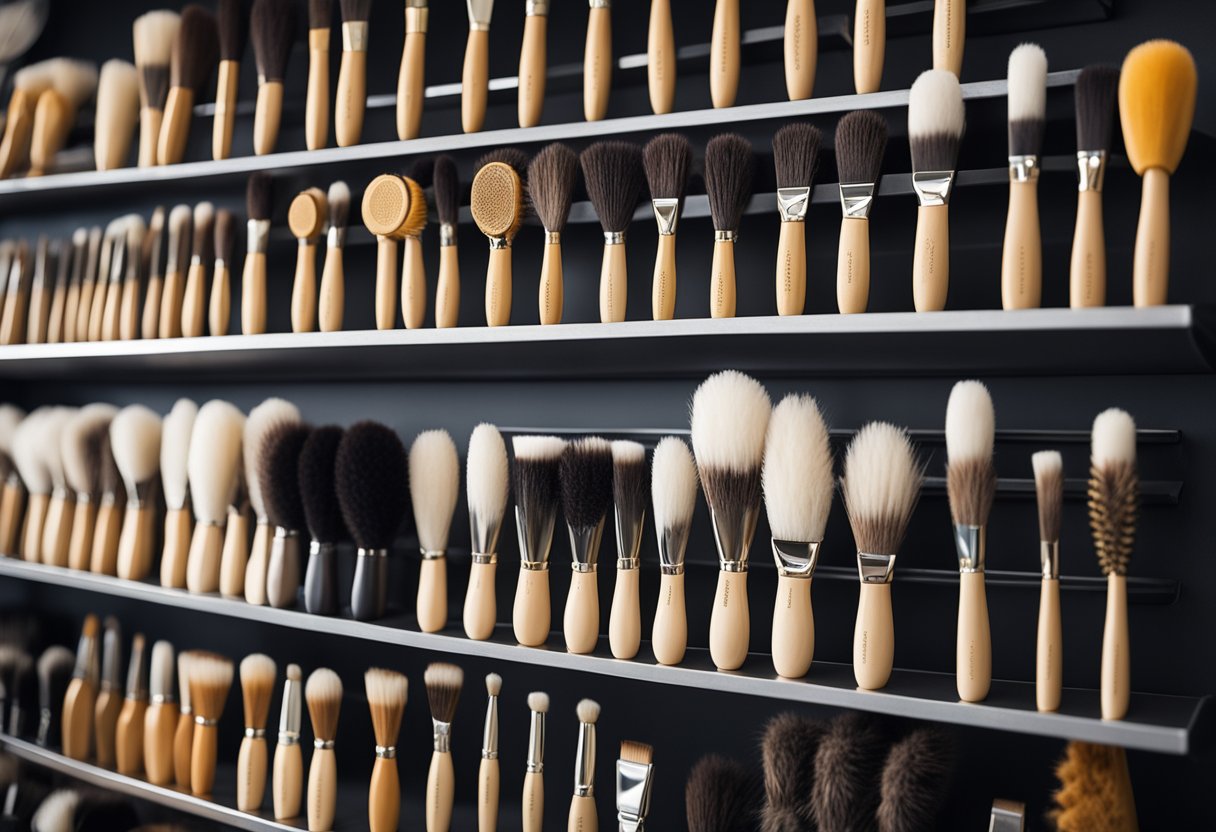How to Choose the Best Brush for Your Dog: A Guide for Pet Owners
Keeping your dog’s coat healthy and shiny is an important part of pet care. Regular brushing can help prevent matting, remove loose fur and dirt, and distribute natural oils throughout your dog’s coat. But with so many different types of dog brushes available, how do you choose the best one for your furry friend?

Understanding your dog’s coat type is the first step in choosing the right brush. Dogs with short, smooth coats may only need a simple bristle brush, while dogs with long, thick coats may require a slicker brush or a combination of different types of brushes. Additionally, dogs with curly or wiry coats may benefit from a pin brush or a comb to help detangle and remove mats.
When selecting a brush, it’s important to consider factors such as your dog’s coat type, size, and temperament, as well as your own experience with grooming. Some brushes may be too harsh for sensitive skin, while others may not be effective for removing mats. With a little research and experimentation, you can find the right brush to keep your dog’s coat looking its best.
Key Takeaways
- Understanding your dog’s coat type is essential for choosing the right brush.
- Factors to consider when choosing a brush include your dog’s size, temperament, and your own grooming experience.
- Regular brushing can help prevent matting, remove loose fur and dirt, and distribute natural oils throughout your dog’s coat.
Understanding Your Dog’s Coat Type

When it comes to choosing the right brush for your dog, the first step is to understand your dog’s coat type. Different coat types require different types of brushes to keep them healthy and well-groomed. In this section, we will explore the two main factors to consider when choosing a brush for your dog: coat length and texture, and shedding and hair growth patterns.
Coat Length and Texture
The length and texture of your dog’s coat play a significant role in determining the type of brush you should use. Here are some common coat types and the brushes that work best for them:
- Short, smooth coats: Rubber brushes, such as the Zoom Groom, work well for dogs with short, smooth coats. Use medium to firm pressure and brush at least once a week and as often as every day.
- Medium-length coats: Dogs with medium-length coats generally need to be brushed every other day. Use a slicker brush or a pin brush to remove tangles and mats.
- Long, silky coats: Dogs with long, silky coats require daily brushing to prevent tangles and mats. Use a slicker brush or a pin brush, followed by a comb to remove any remaining tangles.
- Wire coats: Wire-coated dogs need to be brushed slightly more regularly than short, smooth-coated dogs. Use a slicker brush or a pin brush to remove tangles and mats, followed by a stripping comb to remove any dead hair.
Shedding and Hair Growth Patterns
Another factor to consider when choosing a brush for your dog is their shedding and hair growth patterns. Here are some tips for dealing with different shedding and hair growth patterns:
- Double-coated dogs: Dogs with double coats, such as Huskies and Golden Retrievers, shed heavily twice a year. Use an undercoat rake to remove loose fur during shedding season, and a slicker brush or a pin brush to remove tangles and mats throughout the year.
- Curly-coated dogs: Dogs with curly coats, such as Poodles and Bichon Frises, require regular brushing to prevent mats and tangles. Use a slicker brush or a pin brush, followed by a comb to remove any remaining tangles.
- Smooth-coated dogs: Dogs with smooth coats, such as Beagles and Boxers, shed moderately throughout the year. Use a rubber brush, such as the Zoom Groom, to remove loose fur and keep their coat shiny.
By understanding your dog’s coat type, shedding, and hair growth patterns, you can choose the right brush to keep their coat healthy and well-groomed.
Brush Types and Their Uses

When it comes to dog grooming, choosing the right brush is essential. Different types of brushes are designed for different coat types, so it’s important to choose the one that will work best for your dog. Here are some of the most common brush types and their uses:
Bristle Brushes
Bristle brushes are a great all-purpose brush for most coat types. They come in a variety of sizes and bristle lengths, so you can choose the one that’s best for your dog. Bristle brushes are great for removing loose hair, dirt, and debris from your dog’s coat. They also help distribute natural oils throughout the coat, keeping it healthy and shiny.
Wire-Pin Brushes
Wire-pin brushes are designed for dogs with medium to long hair. They have long, flexible wire pins that are gentle on your dog’s skin. Wire-pin brushes are great for removing tangles and mats from your dog’s coat. They also help remove loose hair and dirt, leaving your dog’s coat looking and feeling great.
Slicker Brushes
Slicker brushes are designed for dogs with medium to long hair. They have short, tightly-packed wire pins angled to go through the coat and avoid the skin. Slicker brushes are great for removing tangles, mats, and loose hair from your dog’s coat. They also help distribute natural oils throughout the coat, keeping it healthy and shiny.
Rakes and Mat Breakers
Rakes and mat breakers are designed for dogs with long, thick hair. They have long, sharp teeth that can penetrate deep into your dog’s coat to remove tangles and mats. Rakes and mat breakers are great for preventing matting and keeping your dog’s coat healthy and shiny.
Remember, choosing the right brush is essential for keeping your dog’s coat healthy and looking great. When choosing a brush, consider your dog’s coat type and choose the brush that will work best for them. With the right brush and a little bit of patience, you can keep your dog looking and feeling great.
Factors to Consider When Choosing a Brush

When it comes to choosing the right brush for your dog, there are several factors you should consider. These include your dog’s size and sensitivity, the brush handle and ease of use, and the maintenance and durability of the brush.
Dog’s Size and Sensitivity
The size and sensitivity of your dog are important factors to consider when choosing a brush. For example, if you have a small dog with sensitive skin, you may want to choose a brush with softer bristles. On the other hand, if you have a large dog with thick fur, you may want to choose a brush with firmer bristles that can penetrate the fur.
Brush Handle and Ease of Use
The handle of the brush and its ease of use are also important factors to consider. You want to choose a brush with a handle that is comfortable to hold and easy to grip. This will make it easier for you to brush your dog for longer periods of time without experiencing discomfort or fatigue.
Maintenance and Durability
Finally, you should consider the maintenance and durability of the brush. You want to choose a brush that is easy to clean and maintain, and that will last for a long time. Look for brushes that are made from high-quality materials and that are designed to withstand regular use.
By considering these factors when choosing a brush for your dog, you can ensure that you choose a brush that is comfortable for your dog, easy for you to use, and that will last for years to come.
Tips for Brushing Your Dog Effectively

Brushing your dog’s teeth is an essential part of their overall health and hygiene. Here are some tips to help you brush your dog’s teeth effectively:
1. Choose the Right Brush
Choosing the right brush for your dog is crucial to ensure that their teeth are cleaned properly. There are various types of brushes available, including finger brushes, traditional brushes, and electric brushes. Consider your dog’s size, breed, and personal preferences when selecting a brush.
2. Use the Right Toothpaste
Using the right toothpaste is also important when brushing your dog’s teeth. Never use human toothpaste, as it contains ingredients that can be harmful to dogs. Instead, use toothpaste specifically designed for dogs, which is safe for them to swallow.
3. Be Gentle
When brushing your dog’s teeth, be gentle and use a soft-bristled brush. Start by letting your dog smell and taste the toothpaste, then gently lift their lip and brush a few teeth at a time. Praise your dog and offer treats throughout the process to help them feel more comfortable.
4. Brush Regularly
Brushing your dog’s teeth regularly is the best way to maintain their dental health. Aim to brush their teeth at least two to three times a week, but ideally every day. If your dog is resistant to brushing, start slowly and gradually increase the frequency over time.
5. Visit Your Vet
Regular dental checkups with your vet are also important to ensure that your dog’s teeth and gums are healthy. Your vet can also provide advice on the best brushing techniques and recommend any additional dental treatments if necessary.
By following these tips, you can help keep your dog’s teeth and gums healthy and prevent dental problems in the future.
Frequently Asked Questions

What are the differences between brush types for various dog coats?
Different dog breeds have different coat types, and each coat type requires a specific type of brush. The most common types of dog brushes include slicker brushes, pin brushes, and undercoat rakes. Slicker brushes work best for dogs with long hair, while pin brushes are recommended for dogs with short hair. Undercoat rakes are designed for dogs with thick undercoats. It is important to choose the right brush that is suitable for your dog’s coat type to prevent matting and promote healthy coat growth.
Which brush type is recommended for dogs with short hair to minimize shedding?
Dogs with short hair tend to shed more frequently than those with long hair. To minimize shedding, a rubber brush is recommended for dogs with short hair. Rubber brushes can help remove loose hair and dirt from the dog’s coat. Additionally, a deshedding tool can also be used to remove loose hair and prevent shedding.
What characteristics define the best brush for double-coated dog breeds?
Double-coated dog breeds have a thick undercoat and a topcoat. The best brush for double-coated dog breeds is an undercoat rake. An undercoat rake has long, metal teeth that can penetrate deep into the dog’s coat to remove loose fur and prevent matting. It is important to choose an undercoat rake with the appropriate tooth length for your dog’s coat type to avoid damaging the skin.
How can one identify the most effective brush for a dog’s grooming routine?
The most effective brush for your dog’s grooming routine depends on their coat type and grooming needs. It is important to choose a brush that is comfortable for both you and your dog to use. Additionally, it is important to choose a brush that can effectively remove loose hair, dirt, and debris from your dog’s coat. Professional groomers can provide recommendations on the best type of brush for your dog’s coat type and grooming needs.
What are the advantages of using a slicker brush versus a pin brush for dogs?
Slicker brushes and pin brushes are both effective at removing loose hair and debris from a dog’s coat. Slicker brushes are designed to penetrate deep into the dog’s coat and remove tangles and mats. Pin brushes are designed to remove loose hair and dirt from the dog’s coat. The advantage of using a slicker brush is that it can effectively remove tangles and mats from the dog’s coat. The advantage of using a pin brush is that it is gentle on the dog’s skin and can be used for daily grooming.
Which brushes do professional groomers prefer for maintaining dog coat health?
Professional groomers prefer to use a combination of brushes to maintain a dog’s coat health. They typically use slicker brushes, pin brushes, and undercoat rakes to remove loose hair, dirt, and debris from the dog’s coat. Additionally, they may use a deshedding tool to remove excess fur and prevent shedding. It is important to consult with a professional groomer to determine the best type of brush for your dog’s coat type and grooming needs.
References:

When it comes to choosing the best brush for your dog, it’s important to do your research and find one that will work well for your furry friend’s specific coat type and grooming needs. Here are some helpful references to guide you in your search:
- AKC.org: This resource provides a comprehensive guide to different types of dog brushes and how to choose the right one for your pet. It includes information on slicker brushes, pin brushes, and more, as well as tips for brushing and grooming your dog.
- NBC News: This article offers expert recommendations for the best dog brushes for a healthy coat. It covers a variety of brush types, including slicker brushes, pin brushes, and curry combs, and includes pros and cons for each.
- The Spruce Pets: This resource features an in-depth review of the 11 best dog brushes of 2024, tested and reviewed by experts. It includes information on the best overall brush, the best combo brush, and the best budget brush, among others.
- Veterinarians.org: This article reviews the top 10 best dog brushes, including double-sided brushes and deshedding brushes. It also includes tips for choosing the right brush for your dog’s coat type and grooming needs.
By using these resources, you can feel confident in choosing the best brush for your furry friend. Remember to consider your dog’s coat type, grooming needs, and personal preferences when making your selection. With the right brush, your dog can enjoy a healthy, shiny coat and a happy, stress-free grooming experience.
